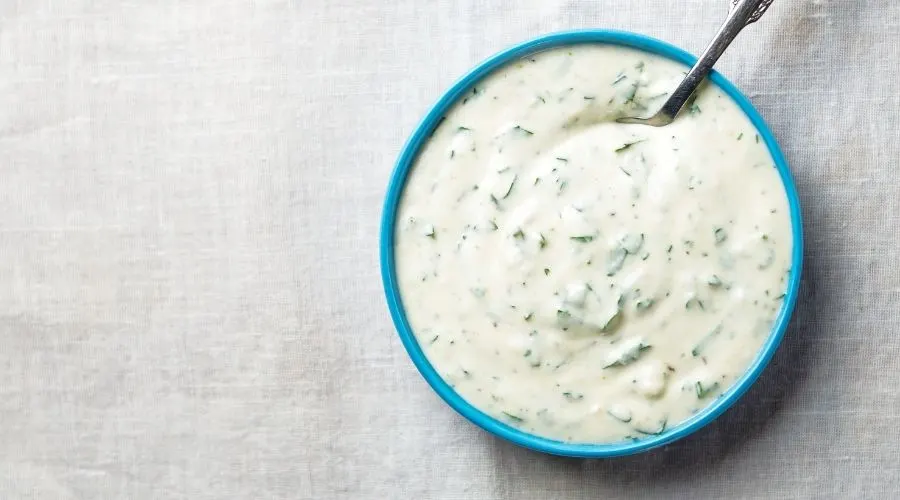There are all kinds of lighter options available for different products but are they any better for us and what makes them a lighter option?
In this article, I wanted to take a look at the difference between the light option of the popular salad dressing ‘ranch’ and the regular (or full-fat) version to find out if it’s better to choose light over regular.
Following head-to-head research, I found out that the main difference between ranch light and the regular version is that ranch light contains more water and less oil, which means it’s lower in calories and fat.
Read on to see the full comparison between the ingredients, the nutritional elements of the dressings, uses, and flavor differences.
Also in This Article
In a hurry, or looking for something specific? Use the links below to jump to the relevant section:
Ingredients Comparision
For this ingredients comparison and other data in this article, I’m comparing top ranch dressing brand Hidden Valley light ranch against their classic ranch dressing.
When comparing the ingredients of each ranch dressing type you can see the difference between light ranch and regular is the main ingredient of light ranch is water, whereas the main ingredient of regular ranch is oil.
Light ranch contains maltodextrin, which is a type of carbohydrate which is added to certain foods to improve texture (you can find out more about maltodextrin in this WebMD Article).
The light version of ranch also contains artificial color which is not listed in the ingredients of regular ranch.
Other than the differences listed above, all other ingredients of light and regular ranch are the same, but light ranch probably contains different amounts of certain ingredients to reduce the calorie content.
| Light Ranch Ingredients | Regular Ranch Ingredients |
Water, vegetable oil (soybean and/or canola), maltodextrin, buttermilk, sugar, salt, less than 2% of: spices, dried garlic, dried onion, natural flavors (soy), egg yolk, modified food starch, phosphoric acid, vinegar, artificial flavor, disodium phosphate, xanthan gum, monosodium glutamate, artificial color, disodium inosinate, disodium guanylate, sorbic acid, and calcium disodium EDTA as preservatives. | Vegetable Oil (Soybean and/or Canola), Water, Buttermilk, Sugar, Salt, Egg Yolk, Less Than 1% of: Spices, Garlic*, Onion*, Vinegar, Phosphoric Acid, Xanthan Gum, Modified Food Starch, Monosodium Glutamate, Natural Flavors, Artificial Flavors, Disodium Phosphate, Sorbic Acid, and Calcium Disodium EDTA Added to Preserve Freshness, Disodium Inosinate & Guanylate. |

Light Ranch Vs. Regular Nutritional Comparison
We’ll now take a look at the nutritional comparison between light and regular ranch dressing to find out the difference between the two.
To make sure the data is accurate, the comparison is made weight-for-weight per serving of each kind of dressing. To confirm, the recommended serving of light or regular ranch dressing is classed as 30ml which is equal to 2 tablespoons.
Calorie Comparison
One of the main differences between light ranch and regular ranch is the calorie content and if this is something that you’re tracking as part of your diet, light ranch is the lower calorie option of the two.
Light ranch contains 60kcal per serving, which is 70kcal less than the same serving size of regular ranch which contains 130kcal.
| Ranch Type | Calories Per 30g Serving |
| Light Ranch | 60kcal |
| Regular (Full Fat Ranch) | 130kcal |
Nutritional Comparison
When comparing the nutritional differences between light ranch and regular ranch, the key difference is the fat content, with light ranch containing 5g of fat compared to regular ranch which contains 13g.
Regular ranch also contains 1g more of saturated fat per serving than light ranch and a small amount of cholesterol, although it’s important to point out that it also contains some good fats too.
If you’re tracking your carb intake, then both sauces are fairly low in carbs, but light ranch contains 2g more carbs per serving than regular ranch making regular ranch the better option if you’re on a low-carb diet such as keto.
| Nutrition Type | Light Ranch (Amount per 30g) | Regular (Full Fat) Ranch (Amount per 30g) |
| Carbohydrates | 4g | 2g |
| of Which are Sugars | 1g | 1g |
| Dietary Fiber | 0g | 0g |
| Fat | 5g | 13g |
| of Which is Saturated Fat | 1g | 2g |
| Trans Fat | 0g | 0g |
| Cholesterol | 0g | 5mg |
| Protein | 1g | 0g |
| Sodium/Salt | 310mg | 260mg |
*mcg = microgram (1000th of a milligram) / mg = milligram (1000th of a gram)
Light Vs. Regular Ranch Uses Comparison
Although light ranch contains less fat and is higher in water, it can still be used in exactly the same way as full-fat or regular ranch, including:
- As a salad dressing.
- As a topping to various types of foods and dishes.
- As a dipping sauce for veggies or pizza.
- As a sandwich or burger topping.
- As a sauce or sandwich mix base.
Because they can be used in the same ways, which one you choose is all down to which dressing you like best and whether you’re looking for a lower calorie dressing which is also lower in fat.

Flavor and Texture Comparison
The texture of light and regular ranch are pretty similar, but the flavor of full-fat ranch is slightly richer because light ranch is slightly watered down to produce a dressing which is lower in calories and fat.
Some people can’t tell the difference and are happy to swap for light ranch, whereas others don’t want to lose out on the richer creamer flavor that you get from the regular version.
When it comes to choosing the best ranch dressing for flavor, this is subjective down to the individual, so we need to do a poll to get a broader opinion.
Please help us by voting for your favorite – light ranch or regular, and once you vote, the winner so far will be revealed (no personal information required to vote).
Summary
We’ve now compared all of the difference between light and regular ranch dressing and here’s a summary of all of the differences between the two:
- The main ingredient of light ranch is water, whereas in regular ranch it’s oil.
- Light ranch contains less than half the amount of calories than regular ranch.
- Regular ranch dressing is higher in fat, but lower in carbs than light ranch.
- Both kinds of dressings can be used in the same ways, depending on which one you like best.
Related Articles
I hope this article has helped you to find the information you were looking for; you might also find the following articles helpful too:
Ranch Vs. Mayo (What’s the Difference?)
Mayo Vs. Ketchup (What’s the difference?)
Canned Sweet Potatoes Versus Fresh Sweet Potatoes (Which Is Better)
References Used for this Article
To ensure the nutritional information used in this article is accurate, I have used data from the USDA and the manufacturer; the links below contain the source information:
Hidden Valley Ranch Dressing USDA FoodData Central Nutritional Information
Hidden Valley Ranch Dressing Manufacturer Nutritional Information
